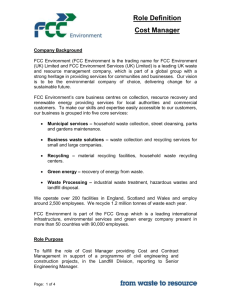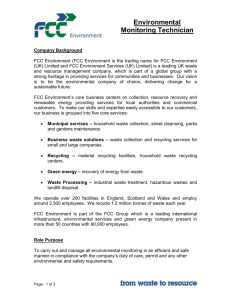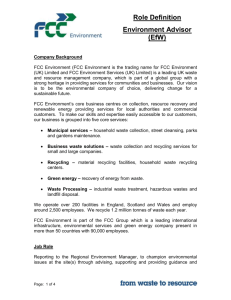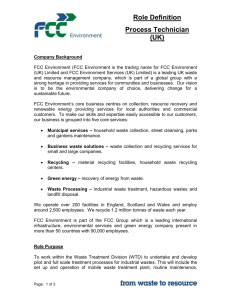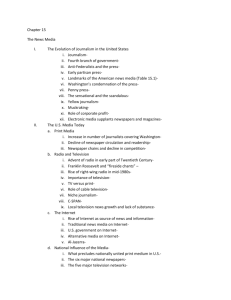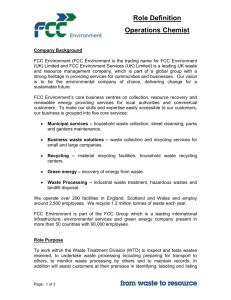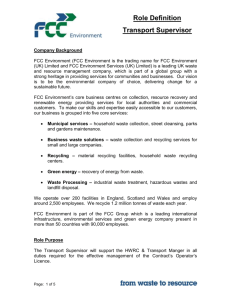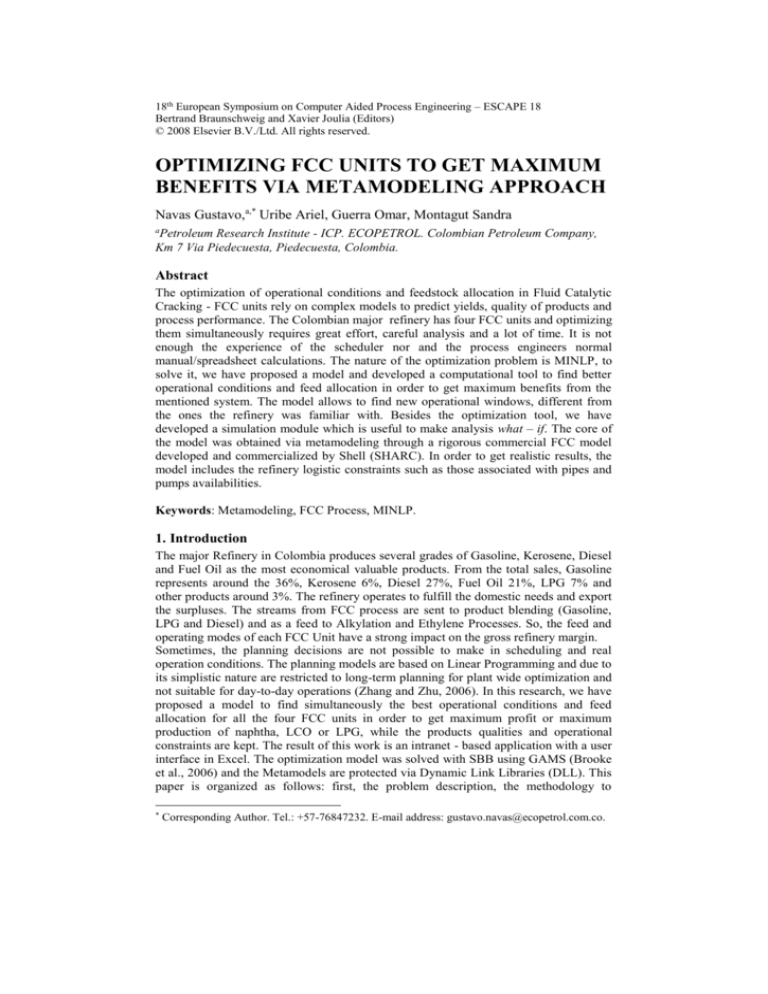
18th European Symposium on Computer Aided Process Engineering – ESCAPE 18
Bertrand Braunschweig and Xavier Joulia (Editors)
© 2008 Elsevier B.V./Ltd. All rights reserved.
OPTIMIZING FCC UNITS TO GET MAXIMUM
BENEFITS VIA METAMODELING APPROACH
Navas Gustavo,a,* Uribe Ariel, Guerra Omar, Montagut Sandra
a
Petroleum Research Institute - ICP. ECOPETROL. Colombian Petroleum Company,
Km 7 Via Piedecuesta, Piedecuesta, Colombia.
Abstract
The optimization of operational conditions and feedstock allocation in Fluid Catalytic
Cracking - FCC units rely on complex models to predict yields, quality of products and
process performance. The Colombian major refinery has four FCC units and optimizing
them simultaneously requires great effort, careful analysis and a lot of time. It is not
enough the experience of the scheduler nor and the process engineers normal
manual/spreadsheet calculations. The nature of the optimization problem is MINLP, to
solve it, we have proposed a model and developed a computational tool to find better
operational conditions and feed allocation in order to get maximum benefits from the
mentioned system. The model allows to find new operational windows, different from
the ones the refinery was familiar with. Besides the optimization tool, we have
developed a simulation module which is useful to make analysis what – if. The core of
the model was obtained via metamodeling through a rigorous commercial FCC model
developed and commercialized by Shell (SHARC). In order to get realistic results, the
model includes the refinery logistic constraints such as those associated with pipes and
pumps availabilities.
Keywords: Metamodeling, FCC Process, MINLP.
1. Introduction
The major Refinery in Colombia produces several grades of Gasoline, Kerosene, Diesel
and Fuel Oil as the most economical valuable products. From the total sales, Gasoline
represents around the 36%, Kerosene 6%, Diesel 27%, Fuel Oil 21%, LPG 7% and
other products around 3%. The refinery operates to fulfill the domestic needs and export
the surpluses. The streams from FCC process are sent to product blending (Gasoline,
LPG and Diesel) and as a feed to Alkylation and Ethylene Processes. So, the feed and
operating modes of each FCC Unit have a strong impact on the gross refinery margin.
Sometimes, the planning decisions are not possible to make in scheduling and real
operation conditions. The planning models are based on Linear Programming and due to
its simplistic nature are restricted to long-term planning for plant wide optimization and
not suitable for day-to-day operations (Zhang and Zhu, 2006). In this research, we have
proposed a model to find simultaneously the best operational conditions and feed
allocation for all the four FCC units in order to get maximum profit or maximum
production of naphtha, LCO or LPG, while the products qualities and operational
constraints are kept. The result of this work is an intranet - based application with a user
interface in Excel. The optimization model was solved with SBB using GAMS (Brooke
et al., 2006) and the Metamodels are protected via Dynamic Link Libraries (DLL). This
paper is organized as follows: first, the problem description, the methodology to
*
Corresponding Author. Tel.: +57-76847232. E-mail address: gustavo.navas@ecopetrol.com.co.
2
Navas G. et al.
develop the FCC models and the mathematical formulation of the optimization problem
are explained; then, the analysis of some studies are shown and finally conclusions are
given..
2. Problem Description
There are five available feeds for each FCC unit: Gasoil from vacuum units (VGO),
DMO from the deasphalting unit, Demetalized oil hydrotreated (DMOH), long residue
from Cusiana crude (CRC) and sometimes Visbreaking Naphtha. These streams are
mixed to make four pools of combined feed for each FCC unit: UOP I, UOP II,
Orthoflow and Model IV. The operational program of the FCC units involves decisions
such as maximize global profit or how to operate in order to satisfy certain quality or
yield restrictions. Each FCC unit has its own operational windows, limitations, and
constraints about the feedstock quality. So that, finding the optimal operating conditions
and feed for each FCC unit is a complex task. Optimizing the four units simultaneously
requires time and effort and it is possible that the feasible solution does not fully exploit
solutions which economically could be more attractive (Pinto,2000). The developed
computational tool solves this optimization problem and also allows to run simulations
in order to make analysis what – if. The process flowsheet is summarized in three
blocks as in Figure 1.
Figure 1. Process Flowsheet.
3. Metamodeling
The core of the model is a module to predict yields, product qualities and some variable
costs for a given feed characterization and operating conditions. The software developed
by Shell global solutions called SHARC was used to get it (Mo, 2002), This software
allows to simulate and optimize the reactor and regenerator section of one FCC unit
based on a previous calibration with reconciled and validated operating data. About 800
simulation runs for each FCC unit were done using SHARC and the results obtained
were used to build the metamodel for each FCC unit, following the methodology
proposed by Palmer and Tsui (2001) and Palmer and Realff (2002a, 2002b). For each
dependent variable a stepwise regression approach was applied to obtain the metamodel
(Myers and Montgomery, 1995). The predicted yields and qualities from the
Optimizing FCC Units To Get Maximum Benefits Via Metamodelling Approach
3
metamodels were compared with the plant data taken from Refinery Information
System (RIS), Process Information (PI) and laboratory data; this comparison showed
that the model has an average observed difference in yields and qualities of less than 3%
vol and 1%, respectively, with respect to plant data.
Two sets of input variables were defined: Operating Conditions (throughput of each
feed, and reactor and preheat temperature), and Physical Chemical properties of the
feed. The dependent variables were grouped in three sets: Yields – expressed in volume
percentage, Products Qualities and Operational Conditions. Each dependent variable is
predicted with a 14-parameter equation. There are 22 inferred variables for each FCC
unit. Since the objective was to represent each FCC unit even beyond the normal
operating window, where the nonlinear nature of the FCC is evident, it was chosen a
non-linear approach which resembled very well the answer of the rigorous FCC model.
With this purpose different models were considered, from a linear model with a nonzero intercept to the polynomial model showed in equation 1.
i n
y a 0 a i xi
i 1
i n 1 j n
i n
aij xi x j aii xi xi
i 1 j i 1
(1)
i 1
Where a0, ai, aij and aii are parameters obtained by stepwise regression, y is the
predicted variable (yields, qualities or operating conditions), xi and xj are independent
variables (feed, physical chemical properties and operating conditions). For each
predicted variable, 140 parameters were calculated.
4. Mathematical Model
There are four possibilities to optimize the FCC units; the goal in every case is to
maximize: profit, naphtha production, LPG or LCO. The profit is calculated as product
sales + octane value – material cost – operating cost as shown in equation 2. The other
objective functions have less terms and are easier to evaluate, equation 3 shows the
option to maximize naphtha production. The model for each FCC unit is represented by
the following equations: Feed flow rate (equation 4); the physical chemical properties of
the feed are obtained from linear relations in volume or weight base (equations 5-6); the
yields, quality of products and operating conditions are functions of physical chemical
properties of the feed and the unit operating conditions as shown equation 7; the form of
this dependance is given by equation 1.
Pr ofit
Pr ices z
Yield Quality
u , yl
uU ylYL
z
uU nN
F
rR
r
u , Feed
u , Feed
u ,n
* Cr
u , n , RON
U Pr ices
uU iop'IOP
Yield u , yl
u ,iop
Oct u ,n EVOu ,n
(2)
y u ,iop
MaxNapftha z u , Feed Yield u ,n
(3)
z u , Feed Fr ,u y r ,u u U
(4)
uU nN
rR
4
Navas G. et al.
z u , Feed * xu ,SPG Fr ,u y r ,u PRr , SPGu U
(5)
rR
z u , Feed * xu ,SPG * xu , p Fr ,u y r ,u PRr , SPG PRr , p
rR
(6)
u U , p P p SPG
Yield u , yl f xu , p , z u ,mop u U , yl YL, p P, mop MOP
(7)
The model can handle the raw material inventories by the equation 8. If the parameter
INVr is fixed to zero, all the raw material r is send to FCC Units.
INVr Fr Fr ,u y r ,u r R
(8)
uU
In the currrent operation, the feed pool sent to UOP I must have the following
constraints: VGO, DMOH and Naphtha could be fed simultaneously to UOP I, while
DMO and CRC are mutually exclusive. For each unit, we have disjuntive propositions
like this and these change every day. To handle these features, the model requires binary
decision variables to solve the feed allocation problem. Each scenario depends on the
availability of pumping lines. In this way, the logistic is presented as hydraulic
constraints. The equation 9 shows this situation applied to UOP I.
y
rR
UOPI , r
4
(9)
yu,r = 1 if the raw material r is a possible feed to the unit u, and yu,r = 0 in the other
case. For this example the variables yUOPI,VGO, yUOPI,DMO,and yUOPI,Naptha are fixed to 1.
The Carbon Conradson and Sulphur content in %wt, are considered as a feed quality for
each FCC Unit, the pumping capacities are given as hydraulic constraints and the feed
rate flow, preheat and reaction temperatures must be kept inside the operating window.
This information is taken as the lower and upper bound to the model.
5. Examples
The potential profit given by the application was tested taking a base case supported by
manual/spreadsheet calculations and by the experience of the planning and scheduling
team. In order to create a basis for comparison, these decisions were simulated and
their results were compared with four scenarios to get maximum profit using the model
proposed in this work (Table 1). We used a HP server model BL35p (AMD Opteron
CPU 2.21 GHz, 4 GB memory), running Microsoft Windows Server 2003 Standard X64
Edition Service Pack 1.
5.1. Base Case.
The information about raw material availability and operational conditions were taken
from the RIS and PI refinery database. The total feedstock to UOP I, UOP II, Orthoflow
and Model IV was 28.42, 30.21, 21.04 and 15.1 MBPD respectively. UOP I is operated
at minimum severity, UOP II and Orthoflow is operated at maximum severity and
Model IV at average reaction and preheat temperatures. The average yields of LPG,
Optimizing FCC Units To Get Maximum Benefits Via Metamodelling Approach
Naphtha and LCO were 24.63%, 53.34% and 17.84% vol respectively. The profit of this
operational schedule was 2987779 $/day.
Table 1. Study of Cases.
5.2. Case 1. Maximize Profit.
In this case, the process profit increases about 3.1 $/bbl. This is due to a decrease in
operational costs of 4.3% and an increment in LPG yield of 8.66 % vol. The model sets
the UOP I and Orthoflow units at maximum severity and UOP II and Model IV at low
severity.
5.3. Case 2. Maximize LPG Production.
Maximizing the LPG yield, increases its production to 9.24% vol. The process profit
increases to 0.30 $/bbl. The severity conditions for each unit are similar to the case 5.2.
5.4. Case 3. Maximize Naphtha Production
In this situation, the naphtha yield increases to 1.91% vol. The process profit increases
to 2.77 $/bbl. However, the naphtha octane does not change. The model suggests to
operate the UOP I, UOP and Orthoflow units at maximum severity and Model IV
operate at minimum severity.
5
6
Navas G. et al.
5.5. Case 3. Maximize LCO Production
Driving the units to this objective, showed an increase of the LCO yield to 9.23% vol.
The process profit decreases to 1.73 $/bbl. This is due to the reduction in the yields of
valuable products like naptha and LPG in about 6.58% and 2.30% vol respectively. The
model suggests to operate the UOP I, UOP II and Orthoflow units at minimum severity
and Model IV operate at maximum severity.
Conclusions
Applying the metamodeling approach using a rigorous model like SHARC, low order
polynomials were obtained as simplified models. These models are the metamodels and
their use reduced in a significant way the high nonlinearlity and the complexity of the
optimization routine as well. The model predictions are within acceptable confidence
intervals and its residual average error is lower than 3% vol. The flexibility of the
optimization routine in allowing four objectives to be maximized (profit, LPG, naphtha
and LCP production) permits that the scheduler and process engineers can quantify the
effect of the decisions to be made in terms of $/bbl, yields and qualities of products. In
the cases analyzed in this paper, the schedule proposed by the model is better than the
base case. Finally, this type of web applications and its use via intranet gives a real
support to ECOPETROL business meanwhile the know how of the ICP is protected; this
approach could be used to support refinery operations remotely.
Notation
Sets: U FCC units, R Raw Material, P physical chemical properties, YL yields, MOP
manipulated operating conditions, IOP infered operating conditions, Q quality products,
N naphtha. Parameters: PRICESu,yl price coefficient of product yl of unit u. Octu,n
reference octane of naphtha n in unit u. EVOu,n price coefficient for quality premium of
naphtha n in unit u. Cr cost coefficient of raw material r. PRICESu,iop cost coefficient of
utility op in unit u. PRr,p physical chemical propiertie p of the raw material r. INVr
inventories of raw material r. Semi continuos variables: Fr,u raw material r sent to unit u.
Continuos Variables: Zu,p physical chemical propertie p of the feed in the unit u.
Yieldu,yl product yield yl in the unit u. Qualityu,n,q quality q of the product n in the unit u.
Binary Variables: yr,u possibility to sent raw material r to unit u.
References
Mo, W., 2002, SHARC – The Shell Advanced And Rigorous Cat Cracking Model, Hydrocarbon
Asia.
Myers, R., Montgomery, D., 1995, Response Surface Methodology. Wiley Series In Probability
and Statictics.
Palmer, K., Tsui, K., 2001, A Minimum Bias Latin Hypercube Design. IIE Transactions, 33, 9,
793 - 808.
Palmer, K., Realff, M., 2002a, Metamodeling Approach to Optimization of Steady State
Flowsheet Simulations. Model Generation. Trans IchemE, 80 (A), October, 760 - 772.
Palmer, K., Realff, M., 2002b, Metamodeling Approach to Optimization of Steady State
Flowsheet Simulations. Trans IchemE, 80 (A), October, 773 - 782.
Pinto, J. M., Joly, M., L.F.L., 2000, Planning and Scheduling Models For Refinery Operations.
Computers & Chemical Engineering, 24, 2259 - 2276.
Rosenthal, R., 2006. GAMS: a user’s guide. GAMS Development Corporation.
Zhang, N., Zhu, X.X., 2006, Novel Modeling And Decomposition Strategy For Total Site
Optimization. Computers & Chemical Engineering. 30, 765 – 777.


